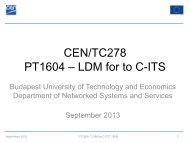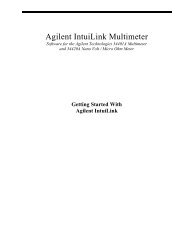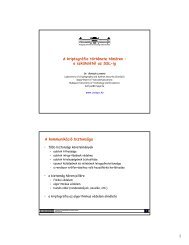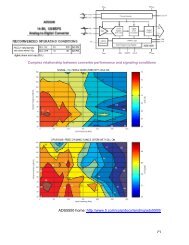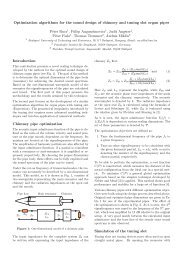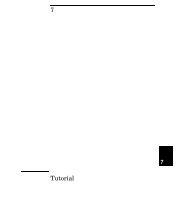IntuiLink Waveform Editor
IntuiLink Waveform Editor
IntuiLink Waveform Editor
You also want an ePaper? Increase the reach of your titles
YUMPU automatically turns print PDFs into web optimized ePapers that Google loves.
About signal imperfections<br />
33220A type ARB generator (14-bit, 50 MSa/s, 64K [or 16K] points) 1<br />
For sine waveforms, signal imperfections are easiest to describe and observe in the<br />
frequency domain using a spectrum analyzer. Any component of the output signal, which<br />
has a different frequency than the fundamental (or “carrier”) is considered to be spurious.<br />
The signal imperfections can be categorized as harmonic, non-harmonic, or phase noise<br />
and are specified in “decibels relative to the carrier level” or “dBc”.<br />
Harmonic Imperfections Harmonic components always appear at multiples of the<br />
fundamental frequency and are created by non-linearities in the waveform DAC and other<br />
elements of the signal path.<br />
Non-Harmonic Imperfections The biggest source of non-harmonic spurious components<br />
(called “spurs”) is the waveform DAC. Nonlinearity in the DAC leads to harmonics that are<br />
aliased, or “folded back”, into the passband of the function generator. These spurs are most<br />
significant when there is a simple fractional relationship between the signal frequency and the<br />
function generator’s sampling frequency (50 MHz).<br />
For example, at 15 MHz, the DAC produces harmonics at 30 MHz and 45 MHz. These<br />
harmonics, which are 20 MHz and 5 MHz from the function generator’s 50 MHz<br />
sampling frequency, will appear as spurs at 20 MHz and 5 MHz.<br />
Another source of non-harmonic spurs is the coupling of unrelated signal sources (such as the<br />
microprocessor clock) into the output signal. These spurs usually have a constant amplitude<br />
(< -75 dBm or 112 µVpp) regardless of the signal’s amplitude and are most troublesome at<br />
signal amplitudes below 100 mVpp. To obtain low amplitudes with minimum spurious<br />
content, keep the function generator’s output level relatively high and use an external<br />
attenuator if possible.<br />
Phase Noise Phase noise results from small, instantaneous changes in the output frequency<br />
(“jitter”). It is seen as an elevation of the apparent noise floor near the fundamental frequency<br />
and increases at 6 dBc / octave with the carrier frequency. The 33220A’s phase noise<br />
specification represents the amplitude of the noise in a 1 Hz bandwidth, 10 kHz away from a<br />
20-MHz carrier (-115 dBc/Hz, typical).<br />
Quantization Errors Finite DAC resolution (14 bits) leads to voltage quantization errors.<br />
Assuming the errors are uniformly distributed over a range of ±0.5 least-significant bit (LSB),<br />
the equivalent noise level is -86 dBc for a sine wave that uses the full DAC range (16,384<br />
levels). Similarly, finite-length waveform memory leads to phase quantization errors.<br />
Treating these errors as low-level phase modulation and assuming a uniform distribution over<br />
a range of ±0.5 LSB, the equivalent noise level is -76 dBc for a sine wave that is 16K samples<br />
long. All of the 33220A’s standard waveforms use the entire DAC range and are 16K<br />
samples in length. Any arbitrary waveforms that use less than the entire DAC range, or that<br />
are specified with fewer than 16,384 points, will exhibit proportionally higher relative<br />
quantization errors. (Note: arbitrary waveform length 2 to 64K points.)<br />
With the 33220A, you can output an arbitrary waveform to an upper frequency limit of 6<br />
MHz. However, note that the useful upper limit is usually less due to the function<br />
generator’s bandwidth limitation and aliasing. <strong>Waveform</strong> components above the function<br />
generator’s -3 dB bandwidth will be attenuated.<br />
1 Signal imperfection for 33120A type ARB generator – see Appendix B.<br />
papay@hit.bme.hu <strong>IntuiLink</strong>: <strong>Waveform</strong> <strong>Editor</strong> (ARB generator) 4



